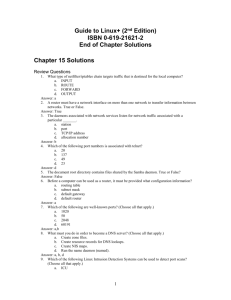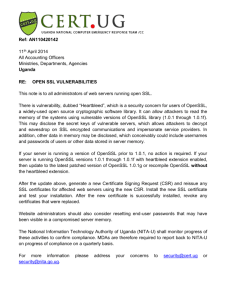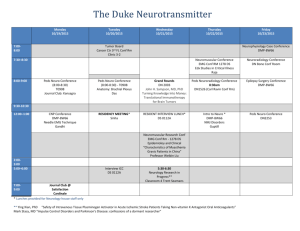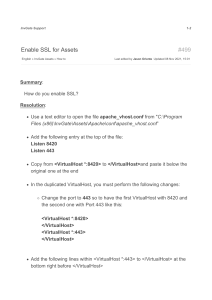Open Source Apache From a 10000 Foot View
advertisement
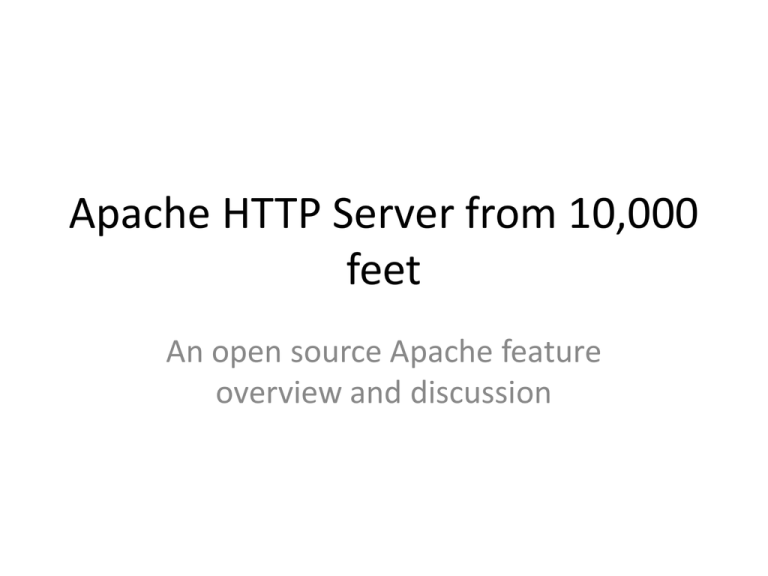
Apache HTTP Server from 10,000
feet
An open source Apache feature
overview and discussion
About the Presenter
About Apache HTTP Server
• Founded 1995 –
built on NCSA httpd
project
• Open Sourced
1999 – version 1.3
• Version 2 2000 –
add threading,
compression, and
openssl support
• Version 2.2 2005 load balancing,
authorization
improvements
• Version 2.4 2012 event mpm, memory
optimization
The very basics
• Have a problem? Look at the Apache doc:
http://httpd.apache.org/docs/2.4/
• Download the newest version
• YES! It works on linux and windows
• Keep everything but docroot together in a custom directory,
unless you’re really used to where Linux stores things
• Start and stop with apachectl (easy) or httpd commands
(more flexible & more than 1 apache install)
• Choose a worker – Prefork (No threads, think php / perl),
MPM (threaded), Event (Lots of simple traffic / keep alive)
• Modules extend Apache and can be dynamically loaded – no
need to compile them with Apache
Basic Configuration
• Have your httpd.conf contain only what modules you
need to start up. Generally avoid <ifmodule> and know
what you’re loading
• Use additional conf files for additional features, and
include them at end of httpd.conf: include
conf/enabled*.conf.
• Files load in alpha numeric – I use
enabledX00_feature.conf
• Limit server information to world with
ServerSignature Off
ServerTokens Prod
See what’s happening with mod_status
Understand what’s happing with logs
• http://httpd.apache.org/docs/2.4/mod/mod_log_config.html
• https://httpd.apache.org/docs/2.4/mod/mod_logio.html
• LogFormat ("%h %l %u %t \"%r\“) (%>s) (%b) (\"%{Referer}i\“)
(\"%{User-Agent}i\“) (%D) (%^FB) (%I) (%O) combined-with-IO
• LogFormat (Date/Time) (request status) (total bytes)
(how we got here) (browser) (total request time) (First
Byte time) (Incoming bytes) (Outgoing Bytes)
• Error logging, most verbose to least: traceX, debug,
info, notice, warn, error, crit, alert, emerg
Virtual Hosting
• Allows Apache to run
multiple domain names
and / or listen on 80 and
443
• Preferred way to use SSL –
SSL always requires a
dedicated IP address, easily
assigned in virtual host
• Can generally configure each virtual host separate
from master httpd.conf and other virtual hosts.
Useful for log names and locations for example.
• Modules inherited from other configuration files
Directing Traffic
• Control traffic to downstream
servers, such as application servers
• Use mod_proxy (proxyPass) for
simple traffic
• Use mod_rewrite (rewriteRule) for
hybrid traffic control, URI changes,
and HTTP to HTTPS translation.
• Use mod_proxy_balance for high
availability traffic control.
Basic Security
• Control Allow / deny access in configurations with
<location>
Require (all / domain / IP) (granted / denied)
• .htaccess allows granular control of access and
configuration by directory, but is also very slow. Ideal for
distributed / multiple user / user administrator situations
• Multiple forms of authentication (user/pass) available, but
not generally secure. Secure via application if possible and
encrypt traffic with ssl.
Certificates with openssl
• Use newest version of Openssl – see Heartbleed,
BEAST, FREAK, Poodle…. …..
• Self Sign certificates for testing and personal use
• Certs composed of csr (certificate signing request), key
(private SSL key), .cer(certificate)
• Scan your site for free for vulnerabilities and
compatibility with Qualys sslabs
https://www.ssllabs.com/ssltest/
Its ALIVE! (and keeping it that way)
• High availability downstream with
mod_proxy_balance
• http://httpd.apache.org/docs/2.4/mo
d/mod_proxy_balancer.html
• Keep it sticky with sticky sessions
• Simple active / passive Apache with
keepalived with VRRP
• http://www.keepalived.org/
• Simple setup sample:
https://raymii.org/s/tutorials/Keepaliv
ed-Simple-IP-failover-on-Ubuntu.html
Appendix 1 - SSL generation script
#!/usr/bin/perl -w
die "usage: autogenSSLcert.pl [certname] [open ssl ver] [sslPasskey]\n" unless ($ARGV[0] && $ARGV[1] && $ARGV[2]);
$certname = $ARGV[0]; $sslVer = $ARGV[1]; $sslPasskey = $ARGV[2];
$country="US"; $state="Maryland"; city="Silver Spring"; $org="Your Organization here";
$unit="Your subsidary / branch / etc here“ ; $email=“webmaster@yourdomain.com”;
print "Generating key for $certname\n";
system "/software/openssl/$sslVer/bin/openssl genrsa -out $certname.key 2048";
print "Generating key for $certname\n";
$cmdFileParams = "|/product/openssl/$sslVer/bin/openssl req -new -key $certname.key -out $certname.csr";
open(SSLGEN, "$cmdFileParams");
print SSLGEN "$country\n";
print SSLGEN "$state\n";
print SSLGEN "$city\n";
print SSLGEN "$org\n";
print SSLGEN "$unit\n";
print SSLGEN "$certname\n";
print SSLGEN "webmaster\@adpselect.com\n";
print SSLGEN "$sslPasskey\n";
print SSLGEN ".\n";
close (SSLGEN);
print "creating self-signed cert for $certname\n";
system "/software/openssl/$sslVer/bin/openssl x509 -req -days 3650 -in $certname.csr -signkey $certname.key -out
$certname.cer";
Appendix 2 – Listing of config files
•
•
•
•
•
•
•
•
•
•
•
•
•
•
•
enabled100dont_log.conf - things I don't log, like monitoring requests
enabled200perf.conf - performance items, like mod_deflate
enabled300status.conf - status page configuration
enabled400custom_pages.conf - custom pages for 40X and 50X
enabled500cgi.conf - CGI configuration to serve perl
enabled600ssl.conf - SSL base configuration and modules
Enabled800cluster.conf – High Availability Clustering Configurations
enabled901domain1_http.conf - domain1 HTTP
enabled901domain1_ssl.conf - domain1 Ssl
enabled902domain2_http.conf - domain2 HTTP
enabled902domain2_ssl.conf - domain2 SSL
enabled903domain1_http.conf - domain3 HTTP
httpd.conf – base configuration
Magic - last resort file to help look at file and determine type
mime.types – describes file type
Appendix 3 – Common rewrites
# Turn On the RewriteEngine and Inherit all globally set rewrite rules
RewriteEngine on
RewriteOptions Inherit
# Only allow REQUEST_METHOD GET and POST, deny all others
RewriteCond %{REQUEST_METHOD}
^(TRACE|TRACK|DELETE|SEARCH|COPY|MOVE|PROPFIND|PROPPATCH|MKCOL|LOCK
|UNLOCK|OPTIONS)
RewriteRule .* - [F]
# Ensure that a request is encrypted, unless….
RewriteCond %{SERVER_PORT} !443
RewriteCond %{REQUEST_URI} !/static
RewriteCond %{REMOTE_ADDR} !10.
RewriteRule ^(.*)$ https://%{SERVER_NAME}%{REQUEST_URI} [L,R]
# Proxy requests, unless they are images or css
RewriteCond %{REQUEST_URI} ^/application(.*)
RewriteRule !(\.gif$|\.jpg$|\.css$) http://appserver1:8080%{REQUEST_URI} [P]


